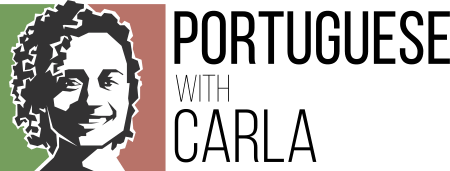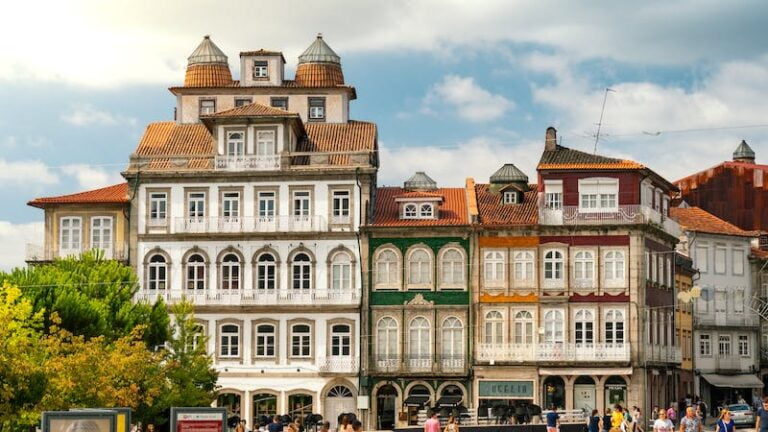Unveiling The Origin of The Portuguese Language – Part 1
Portuguese is a widely spoken language, taking the 8th spot in the world ranking. Most people know that, along with the other Romance languages, it came from Latin. Others have already learned about its connection to medieval Galician.
But what is the true origin of the Portuguese language? How did it get to where it is today? What are the different Portuguese dialects and variants?
Welcome to a new series about the history of the Portuguese language. You will dive deep into the current landscape of Portuguese and understand how it came to be. Discover what influences shaped how Portuguese language speakers express themselves.
Learning about the Portuguese language origin will help you grow as a learner. You will understand its relationship to other Romance languages and build a stronger bond with the culture it represents.
The History of Portuguese Backwards
Do you want to learn European Portuguese? Sign up for The Journey, an interactive language course like no other! Based on an original feature film, it introduces the Portuguese culture, language, and people. You can expect real-life dialogues at natural speed, an immersive learning experience, and much fun. Start your free trial today!
Like many languages spoken around the world, Portuguese does not have a linear history. The further you go back in time, the more blurred you will find the lines distinguishing it from other languages. Thus, we invite you to take an unconventional turn and look into history. Start by understanding what the Portuguese language is today.
The Modern Portuguese Language
As mentioned before, Portuguese is among the most spoken languages on Earth. You will find native speakers of this Romance language in almost all countries around the world. World Population Review points to about 279 million Portuguese speakers. This number includes speakers of all its variants and dialects. There is even a World Portuguese Language Day on May 5th.
Portuguese-Speaking Countries
Portuguese is the official language in nine countries. These are also called lusophone countries and are part of the CPLP (Comunidade dos Países de Língua Portuguesa). The territory encompassed goes much further than the Iberian Peninsula.
It spreads throughout most continents, including Brazil, the largest of South American countries. Portuguese-speaking African countries are Mozambique, Angola, Cape Verde, São Tomé and Princípe, Guinea-Bissau, and Equatorial Guinea. In Asia, East Timor has it as one of the official languages, and so does Macau, a Special Administrative Region (SAR) of China.
Most of these countries have other official languages. In many cases, Portuguese is taught in schools and used in more formal contexts. But it is not the native language of the locals.
Variants and Dialects
Portuguese has two main variants, the European and the Brazilian Portuguese, each with their respective dialects. Native speakers of both variants often comment on their differences. They have distinct pronunciation, grammar, and vocabulary. Still, despite the occasional misunderstanding, they can easily comprehend each other.
Then, the language spoken in each country changes slightly with the influence of other languages and dialects spoken nearby. Portuguese-speaking African countries use many words from local dialects and languages. Some terms, like Bué (A lot) and Bazar (To leave/go away), from the Angolan tongue Kimbundu, have also become part of the European Portuguese lexicon.
Additionally, Portuguese-based pidgins and creoles developed throughout the centuries. Many languages, like Japanese, English, and Spanish, also include Portuguese words.
The European Portuguese Variant
Modern Portuguese encompasses multiple variants despite being considered a single language. Most Portuguese speakers understand each other regardless of their native or chosen variant. At Portuguese With Carla, we focus on teaching the European Portuguese variant. Here is its latest history.
European Portuguese Before the 21st Century
European Portuguese is the variant spoken in Portugal, comprising only about 5% of native speakers worldwide. Its characteristics include the repeated occurrence of nasal sounds, shortened vowels, and the use of diacritics in writing.
Like many other countries, Portugal struggled with illiteracy. Thus, especially from the 19th century onward, the Portuguese government strived to increase alphabetization. The national Educational system was only duly established in the 20th century. And the illiteracy rate was still 3,1% in 2021, higher than other European countries.
During that time, the state made several reforms to unify and standardize, especially the written language. It established official patterns for orthography and punctuation. For example, after the beginning of the first Portuguese Republic in 1910, the government formed a commission to simplify the writing system.
Additionally, in 1990, the countries in the CPLP developed the Portuguese Language Orthographic Agreement. This treaty sought to standardize the Portuguese orthography and was ratified in Portugal in 2008. The reactions were mixed, with some natives supporting its implementation and others condemning it.
Because of that, most writing follows a standardized norm. Conversations, on the other hand, are much more fluid. Individuals change their speaking according to the situation, location, record, and conversation partners.
The Printing Press and The Portuguese Language
Before that, in the 16th century, the printing press was also an impactful tool for the Portuguese language. Written works became available to more people, leading to knowledge dissemination. They also ended up promoting the specific Portuguese variants chosen by their authors.
It was a flourishing time for Portuguese literature. In 1536, Fernão de Oliveira, one of the earliest Portuguese grammarians, published the Grammatica da Lingoagem Portuguesa. It was the first book that gathered the Portuguese lexicon into a single volume.

One of the most famous Portuguese writers, Luís Vaz de Camões, lived during this time. His work – Os Lusíadas – had a tremendous impact on the Portuguese language. Shortly after, in the 17th century, the first magazines and journals were published in Portugal.
The Portuguese Discoveries
The Discoveries Era coincided partly with the arrival of the printing press. The expansion of the Portuguese empire happened mainly between the 15th and 16th centuries. It also meant an expansion of the territory in which Portuguese was the main or among the main languages spoken.
During this time, Portuguese became a lingua franca and gave many of its words to other languages. For example, Japanese has terms like Furasko, which means Jar and came from the Portuguese word Frasco. This interchange also shaped some of the evolution of Portuguese, as it absorbed many words from around the world.
Descobrimentos, by Emanuele, licensed under CC BY-SA 2.0 Deed
A Short History of The Brazilian Portuguese Variant
The Portuguese discovered and colonized Brazil in the 16th century. From then onward, Portuguese was the language chosen for communication between local officials and Europeans. It was used for all colonial administration and trade.
After about three centuries of Portuguese rule, the country became independent in 1822. Still, the language remained. It molded itself to the influence of many other languages and local dialects. The several waves of immigration to Brazil throughout the years also helped turn it into its own variant.
Portuguese-based Creoles and Dialects
As the Portuguese spoken in different regions evolved and mixed with local dialects, more languages emerged. When people from diverse cultures and speaking unrelated languages gathered together, they developed pidgins, which allowed them to communicate. Yet, these were still unfinished languages.
The next generations of children would complete what those pidgins lacked and formed creoles. Some of these languages with a specific grammar evolved and are still spoken today. For example, Kabuverdianu is the Creole spoken in the Cape Verde islands. It includes many words a Portuguese person can recognize but has a different orthography and grammar.
Other pidgins and creoles of Portuguese origin have disappeared or their speakers are becoming fewer and fewer. This declining situation is present in several Asian countries like India, East Timor, and Sri Lanka.
Portuguese as an Official Language
Portuguese became an official language in 1290, under the rule of King D. Dinis. He established the first Portuguese University in the same year in Lisbon. It later moved to Coimbra, where it stands as one of the most important in the country.

Old Portuguese started being the language used for royal documentation. At this time, each region in Portugal had its particular dialect. But the nobility spoke the dialect from the Northern districts.
When Lisbon became the capital in 1255, the royal power concentrated there, and their dialect became the most important one. At the time, it was called Common language. Only later, in the 15th century, would it gain the name we recognize today – Portuguese.
These developments were crucial for the growth of Portuguese literature later on. They were also one of the most significant steps for creating a national identity, which led to all the other happenings mentioned before.
Are you dreaming of learning Portuguese? Start today with The Journey! Take an engaging trip to Portugal and dive into its landscapes and culture. Learn a new language through exposure and science-based methods that will keep you motivated from day 1.
Learn European Portuguese the Instinctive Way!
For the last decade, we’ve been working on putting together the best possible European Portuguese course. After much research, feedback from our students, and several iterations, we think we’ve got it! 😉
At the base of it all is a sound conviction that languages are better learned instinctively, so the process needs to engaging, varied, and enjoyable. Throughout, we used scientifically proven techniques to help you master pronunciation, phrase construction, oral understanding, grammar, and all the necessary bits to get you to fluency. And still, the whole thing is presented as an adventure. It’s a course like no other, trust us!
Continue Exploring The Origin of Portuguese Language
Like any other, this Romance language dictates how Portuguese speakers live and think. The same language bonds millions of people and communities, from South America to Europe, Africa, and Asia.
Exploring Portuguese language history allows you to understand what influences shaped it. It makes your language learning process more comprehensive, giving you a look into the past of a people and their mother tongue.
Don’t miss part 2 of this series, coming out next week! You will discover more about how Portuguese emerged and its diverse origins. Learn more about Galician Portuguese, once spoken in the Western Iberian Peninsula. Explore the role of classical Latin, spread by the Roman Empire and vulgar Latin spoken by Roman soldiers. And travel further into the past to uncover the influences that shaped Portuguese and other European languages.
Do you know any interesting facts about the origins of your mother tongue? Feel free to share it with us below, as we love to hear about other languages. Additionally, watch our Interview with a Portuguese Expert to dive even deeper into the Portuguese language.












For me, the most interesting thing was the situation/attitudes about the voçe and tu; and then contrasting with the English you.
It was great info overall as these are important aspects of language.
Obrigada-
Maike
Olá Maike,
The “você” and “tu” subject is indeed very interesting!
We are glad you enjoyed the info in this article 🙂
Obrigada e tem um bom dia!